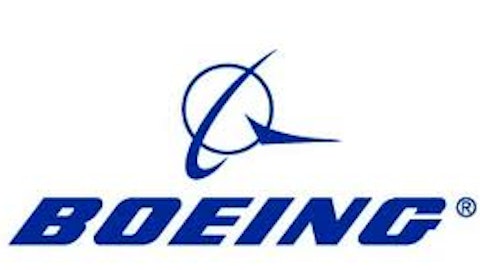With the increasingly tight global village, countries like China and the United States seem more like neighbors than ever before. Analysts of the airline industry have said globalization will increase air traffic significantly, and on June 11, The Boeing Company (NYSE:BA) reinforced that sentiment when it made a major statement, saying the number of commercial aircraft throughout the world will double in the next 20 years.
What that means for airline companies
Many airline fleets are aging, so that means there is ample opportunity for those who manufacture planes to increase sales through new orders. Those older vessels are also not as fuel efficient, which also encourages airline operators to purchase more fuel-efficient models, particularly due to rising oil prices.
According to Randy Tinseth, The Boeing Company (NYSE:BA)’s vice president of marketing, cheap operational costs and efficiency are the major factors in providing quality airplanes. “The contribution of fuel to the cost of flying planes has doubled,” he told the Guardian. “As a result, we see customers looking foremost at efficiency — in fuel, but also in maintenance and labor, the second-highest cost contributors.”
The growing global middle class
The Boeing Company (NYSE:BA) said that many of the sales will be in the Asia-Pacific region. The area is the subject of a rapidly increasing middle class, and with the population of China alone reaching more than 1.3 billion, that’s a lot of people setting out on dream vacations or conducting business overseas.
The demand, The Boeing Company (NYSE:BA) says, will result in the order of more than 35,000 new aircraft, representing about $4.8 trillion (yes, trillion). Many of those new planes will replace the old, and bring to total number of planes to around 40,000 around the world. Boeing expects cargo and passenger traffic will increase by 5% each year.
Do the numbers support Boeing’s sales expansion theory?
With first-quarter results posting a decrease in sales of products over the previous year of over $300 million, the future at first glance doesn’t look to be here quite yet. But in taking a closer look, the company has nearly $2 billion in accounts receivables in 2012, compared to less than $1 billion the year before and only $320 million in 2009. Also, total cash from operations in 2012 was $7.5 billion compared to $5.6 billion in 2009.
Furthermore, the company increased inventories by about $3 billion from 2011 to 2012, showing the firm could be building up for large demand. The increase represents a 4% rise from the previous year. Putting that into context: 2010 and 2011’s increases were identical at 2.5%. This shows the company could be ramping up efforts to build inventory to meet future demand.
Other companies set to profit
Honeywell International Inc. (NYSE:HON) is also in a solid position to profit from an increase in aircraft sales. The company manufactures airplane controls, engines and other related equipment. The firm’s financial results have been mixed, with the company reporting an increase in earnings of 17% in the latest quarter. However, net sales and receivables were static compared to 2012’s first-quarter results. Inventories actually decreased by about 1% at Honeywell, so unlike The Boeing Company (NYSE:BA), the company doesn’t seem to be making plans for increasing sales.
Honeywell International Inc. (NYSE:HON) is more diversified than Boeing, however, and therefore represents a safer bet if you are looking to invest in a company closely tied with aerospace but not entirely consumed by the market. On June 11 the firm revealed a Wi-Fi-controlled thermostat better able to monitor energy consumption. The device is meant to be used by municipalities throughout the United States to ensure accurate energy readings.
Other players needed to make planes
With all those new aircraft in the sky, there will also be the need for state-of-the-art hydraulics. Parker-Hannifin Corporation (NYSE:PH) adds up to a buy for the technical investor: its return on equity is around 19%, and operational margins are 12%, which is just above the 11% industry average. The financial stability of the company indicates it is ready to deliver when called upon for its hydraulics systems.
The company was part of the June 14 Airbus and Rolls-Royce first flight of the Trent XWB. Parker provided the fuel and hydraulic systems, landing gear hydraulic dressing, engine built unit, and other equipment for the twin-aisle jetliner. The successful launch is a major boost for Parker because the aircraft is state-of-the art in its abilities to be comfortable for passengers, fuel-efficient and reliable. That boosts Parker’s street cred.
Parker-Hannifin Corporation (NYSE:PH)’s business-segment revenue is fairly distributed internationally, which means the firm could meet the demand of any nation that asks for its high-end products — thus meeting the demands of globalization. The company is certainly cutting edge, and diversified.
On June 10, it released a new compressed air testing device that can detect microbial contamination in compressed air systems. The device is appropriate for testing food contact surfaces and food itself, as well as the dark, moist habitat in compressed air systems that could result in infected food and food surfaces.
According to the company’s press release, the device is in demand because it is much less expensive than comparable devices. That could lead to major profits from the sale to restaurants and factories that produce food.
Where to put your money
As long as teleportation remains fictional, investors can be certain of rising profits for companies in the aerospace industry. Betting on Boeing is putting all your chips into the industry, but if the sector takes off, so could your portfolio. Honeywell and Parker Hannifin, while heavily weighted in aerospace, are more diversified and could be the safer bet for the conservative investor.
Phillip Woolgar has no position in any stocks mentioned. The Motley Fool has no position in any of the stocks mentioned.
The article Boeing: ‘Air Traffic to Double Within 20 Years’ originally appeared on Fool.com and is written by Phillip Woolgar.
Phillip is a member of The Motley Fool Blog Network — entries represent the personal opinion of the blogger and are not formally edited.
Copyright © 1995 – 2013 The Motley Fool, LLC. All rights reserved. The Motley Fool has a disclosure policy.





